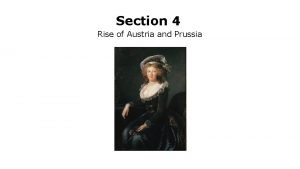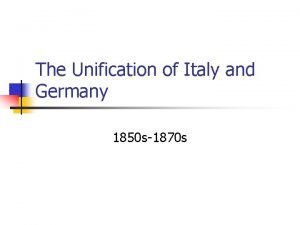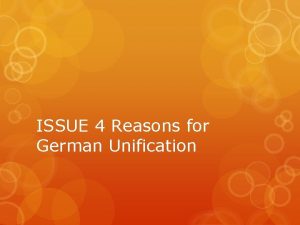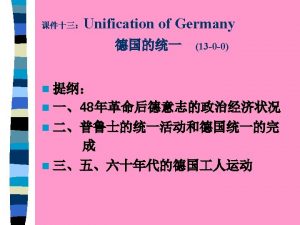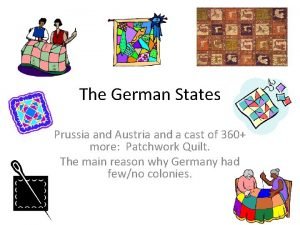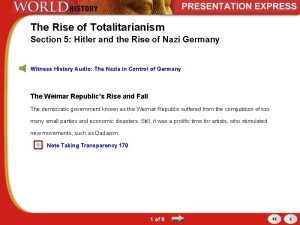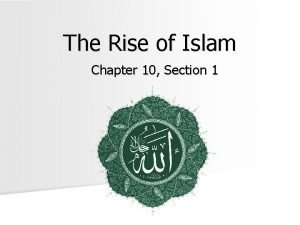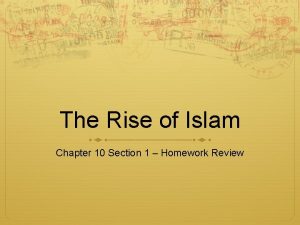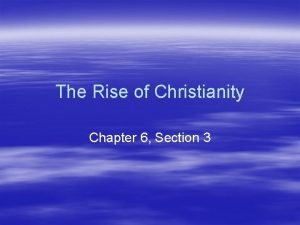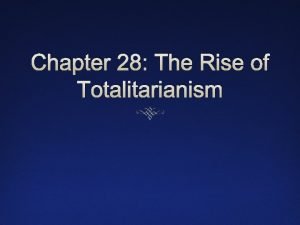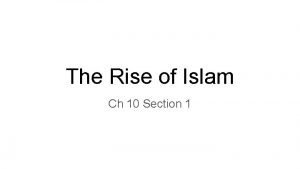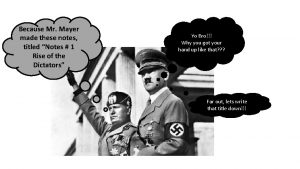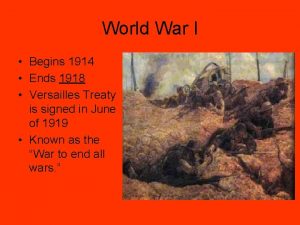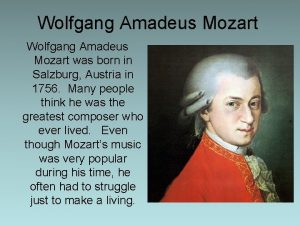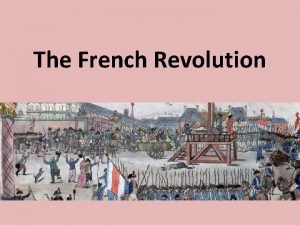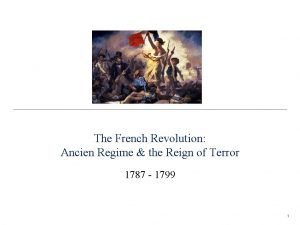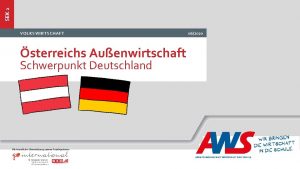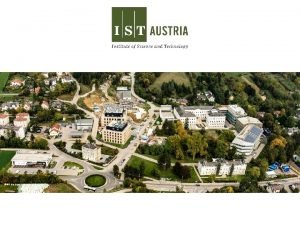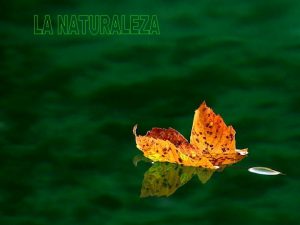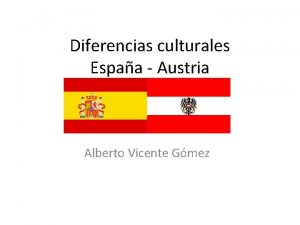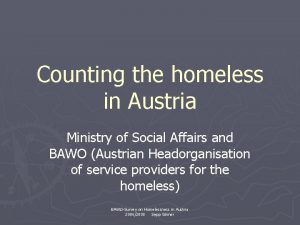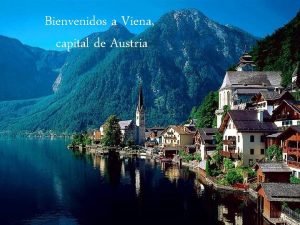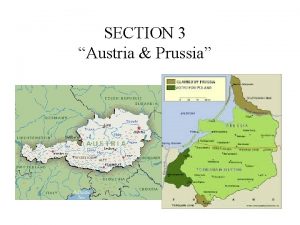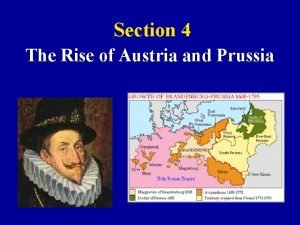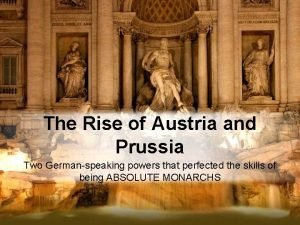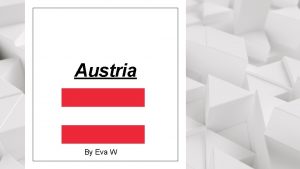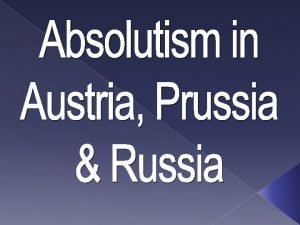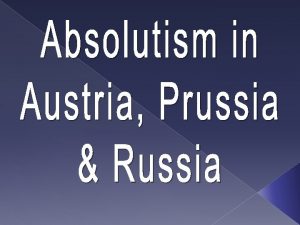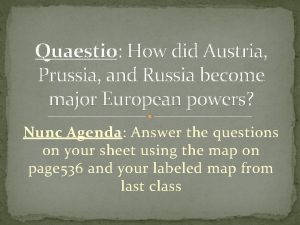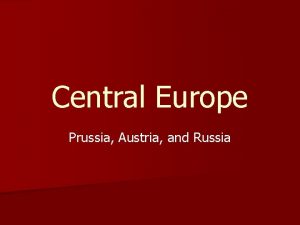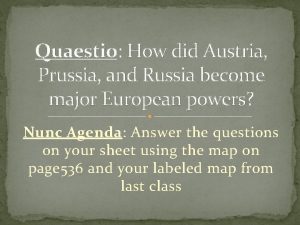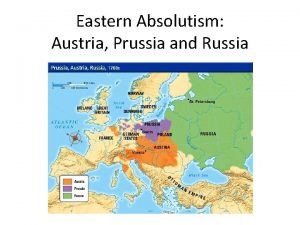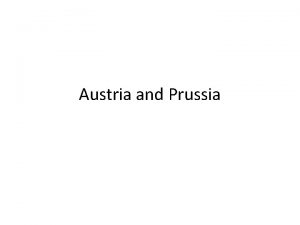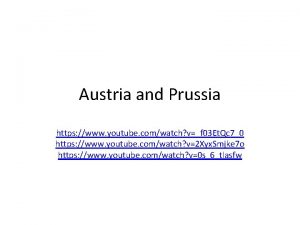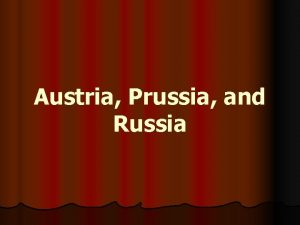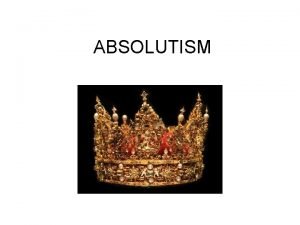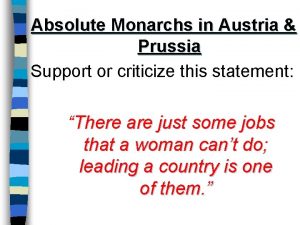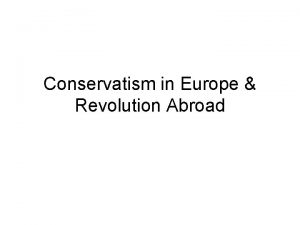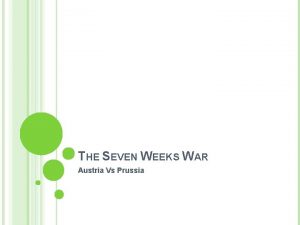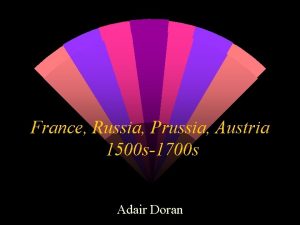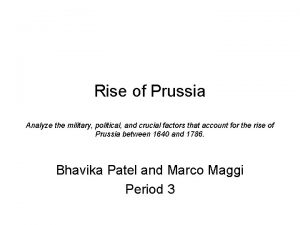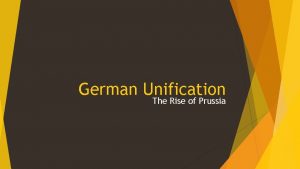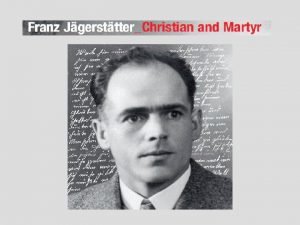Section 4 Rise of Austria and Prussia Learning































- Slides: 31

Section 4 Rise of Austria and Prussia

Learning Targets • Understand how Austria and Prussia emerged as great powers. • Examine the various economic and political systems of European nations in relation to the rise of the America. • Compare the causes and effects of the development of constitutional monarchy to absolute monarchies

Terms and People (continued) • Frederick William I – a Prussian ruler who came to power in 1713 and gained the loyalty of the Prussian nobles to increase his control of the state • Frederick II – the son of Frederick William, who became king of Prussia in 1740 and seized Silesia from Austria, sparking the War of the Austrian Succession • Prussia – a strong military state that emerged in central Europe in the late 1600 s

How did the two great empires of Austria and Prussia emerge from the Thirty Years’ War and subsequent events? After the Thirty Years’ War ravaged the German states of Austria and Prussia, the two powers coexisted. Their rulers became absolute monarchs who ruled in Europe with no check on their power.

By the seventeenth century, the Holy Roman Empire was a loose patchwork of separate states. In theory, these states were ruled by the Holy Roman emperor. But in reality, the emperor, who was chosen by electors, had little power. The lack of a central authority led to the outbreak of the Thirty Years’ War.

The Thirty Years’ War began in 1618 when king Ferdinand tried to suppress Protestants in Bohemia. • Protestant nobles threw two royal Catholic officials out of a window. This became known as the Defenestration of Prague, and sparked a revolt. • As both sides sought allies, the war widened into a general European war. • A religious conflict changed into a political war for control of Europe. Catholic and Protestant rulers shifted sides to suit their own interests.

The Thirty Years’ War was very brutal. Mercenaries burned villages and killed without mercy. Wolves roamed the streets of deserted villages. Severe depopulation occurred. As many as one third of people may have died in the German states.

The Peace of Westphalia ended the war in 1648. The treaties aimed to create a general European peace. France gained the most territory. Germany was divided into more than 360 separate states.

After the war’s end, the Hapsburgs in Austria wanted to create a strong, unified state. This was difficult, because the lands they wanted to unify were made up of many diverse peoples and cultures. Despite efforts to bring Austria, Bohemia, Hungary, and parts of Poland together, the Hapsburgs never created a central government like the one in France.

European nation-states in 1700

Hapsburg emperor Charles VI died in 1740 and left the throne to his daughter, Maria Theresa, who immediately had to fight a new war. The War of the Austrian Succession began when the king of Prussia seized an Austrian province. With the help of her Hungarian subjects as well as Britain and Russia, Maria Theresa preserved her empire.

Maria Theresa was a good leader. • Though she did not succeed in throwing Prussia out of the Austrian province it invaded, she did win the support of her people. • She also reformed tax collection and eased the burden on peasants.

While Austria grew as a Catholic state, Prussia emerged as a Protestant power. • Prussia was created in the 1600 s when the Hohenzollern family united their lands. • Frederick William I came to power in 1713 and gained the loyalty of nobles by giving them positions in the army and government. • He stressed military values and created one of the besttrained armies in Europe.

Frederick trained his son Frederick II in the art of war. When the prince became king in 1740, he seized Silesia from Austria, sparking the War of the Austrian Succession. https: //www. youtube. com/watch? v=o. Bv. ZAPQVIro He forced Europe to see Prussia as a great power and became known as Frederick the Great.

To maintain a balance of power, European states formed various alliances in the 1700 s. Still, two basic rivalries persisted. Prussia Austria Britain France These rivalries sometimes resulted in worldwide conflict, as in the Seven Years’ War between 1756 and 1763. The Treaty of Paris ended this war and gave Britain a huge empire.

Section 5 Absolute Monarchy in Russia

Objectives • Explain how Peter the Great tried to make Russia into a modern state. • Describe how Catherine the Great strengthened Russia. • Examine the various economic and political systems of European nations in relation to the rise of the Americas • Compare the causes and effects of the development of constitutional monarchy to absolute monarchies • Compare the philosophies of democracy, capitalism, socialism, and communism

Terms and People • Peter the Great – a Russian tsar who took control of government in 1689 and used his power to modernize Russia • boyar – a landowning noble

Terms and People (continued) • warm-water port – a port that is free of ice all year • St. Petersburg – capital city and major port that Peter the Great established in 1703 • Catherine the Great – Russian empress as of 1762 who embraced Western ideas and ruled as an absolute monarch

How did Peter the Great and Catherine the Great strengthen Russia and expand its territory? Russia was still a medieval state in the 1600 s, after having suffered a period of disorder and invasions. In the late 1600 s, Peter the Great came to power and worked to modernize the nation. Catherine the Great continued his efforts.

Peter the Great took control of Russian government and set out to modernize it. He traveled to European cities in 1697. There, he learned about new technologies and was impressed by Parliament in England. Peter brought back experts from Western Europe to help his policy of westernization. To force the change, he was very autocratic, ruling with unlimited authority.

Peter worked to control the Russian clergy and nobility. • He put the Russian Orthodox Church under his control. • He made the boyars serve the state, shave their traditional beards, and switch to Western-style dress. • In return, he strengthened serfdom.

Peter was not afraid to use force to reach his goal. Peter’s reforms were both social and economic. If anyone revolted, he had them killed. He adopted mercantilist policies to pay for his reforms. He imported technology, improved schools, improved canals, and developed new industries.

Peter also sought to expand Russia’s borders so that it could have a warm-water port. • To this end, he built the largest army in Europe as well as a world-class navy. • Peter was not able to push through the Ottoman Empire to get his warm-water port. • By the end of the eighteenth century, Catherine the Great would finally achieve this goal.

Peter started a war against Sweden in 1700. He defeated them in 1709 and gained territory along the Baltic Sea. There, he built a new capital city, St. Petersburg, to rival any in Europe. It became a symbol of Peter’s goal of modernizing Russia.

During this time, Russia also expanded eastward. • Peter signed a treaty with China that recognized Russia’s claim to lands north of China. • He hired Vitus Bering to explore the strait between Siberia and Alaska. • These expansions made Russia the world’s largest country. It remains so today.

Peter the Great left a mixed legacy. Positives Negatives Ended Russia’s isolation Reforms died with him Expanded Russia’s territory and gained ports on the Baltic Sea Used terror to enforce his will Built a big army Policies led to the growth of serfdom

Russia expanded its territory between 1689 and 1796.

Peter died without an heir and a power struggle ensued. Russian nobles became more and more independent. Then a new monarch took power. She came to be known as Catherine the Great.

Catherine was a German princess who wed the heir to the Russian throne in 1745. In 1762, a group of army officers deposed her mentally unstable husband. With their support, Catherine took the throne as empress of Russia. Catherine proved an effective and able absolute monarch. • She embraced Western ideas. • She reorganized government and codified laws. • She opened state-sponsored schools for children.

She could also be ruthless. Peasants revolted against the harsh conditions of serfdom. Catherine repressed the rebellion and even more peasants were forced into serfdom. Along with King Frederick II and Emperor Joseph II of Austria, Catherine partitioned Poland took control of its eastern lands in 1772, removing the state from the map. https: //www. youtube. com/watch? v=e. Wkjihcn. Z 8 g
 Rise of austria and prussia
Rise of austria and prussia Tricky dick
Tricky dick Rise and rise again until lambs become lions
Rise and rise again until lambs become lions Little lambs academy
Little lambs academy A union b example
A union b example Where was prussia in 1850
Where was prussia in 1850 230 mall boulevard king of prussia
230 mall boulevard king of prussia Prussia now
Prussia now Origin of prussia
Origin of prussia Prussia
Prussia 30 years war causes
30 years war causes Cuadro comparativo e-learning b-learning m-learning
Cuadro comparativo e-learning b-learning m-learning The rise of totalitarianism section 5 quiz
The rise of totalitarianism section 5 quiz Islam beliefs and practices
Islam beliefs and practices The rise of islam chapter 10 section 1
The rise of islam chapter 10 section 1 Chapter 6 section 3 the rise of christianity
Chapter 6 section 3 the rise of christianity Chapter 28 section 3 fascism in italy
Chapter 28 section 3 fascism in italy The rise of islam chapter 10 section 1
The rise of islam chapter 10 section 1 Germany and austria join in the anschluss
Germany and austria join in the anschluss Was austria hungary a country
Was austria hungary a country Wolfgang amadeus mozart was born in
Wolfgang amadeus mozart was born in Austria email lwpk 8 eco
Austria email lwpk 8 eco French revolution timeline
French revolution timeline Ancien régime
Ancien régime 2 sek austria
2 sek austria Ist austria summer internship
Ist austria summer internship Sucesin
Sucesin Monumento a maria cristina d'austria
Monumento a maria cristina d'austria Cueva de hielo austria
Cueva de hielo austria Diferencias culturales entre espana y austria
Diferencias culturales entre espana y austria Homeless in austria
Homeless in austria La bella capital de austria
La bella capital de austria
